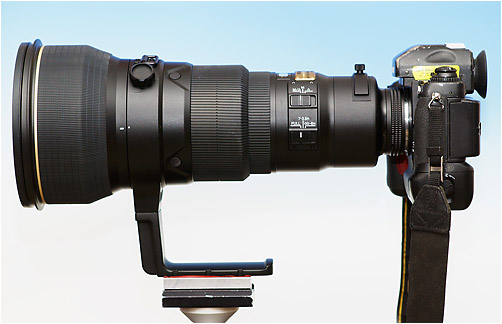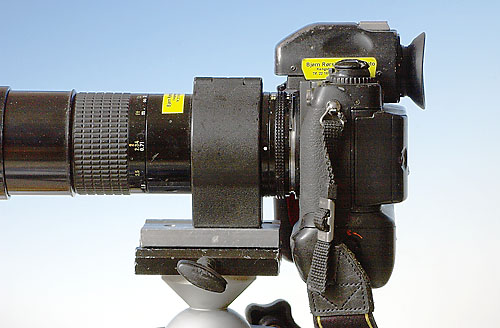Tripod Collar Blues
The Good, the Bad, and the Ugly
by
Bjørn Rørslett |
| First
| 2 | 3 | Last | Page
|
| |
|
Some lenses have
it, some should have but haven't - I'm thinking of tripod collars
on long lenses, the quality of which ranges from appalling to
excellent. Recently, poor tripod collar designs are, for strange
and obscure reasons, rapidly becoming the norm.

|
Unsafe at Any Speed
|
© Bjørn Rørslett/NN
|
This AFS 400 mm f/2.8 Nikkor
exemplifies the current design trend for poor tripod
collars. Though they may look trendy and slick, such
tripod arrangements are next to useless for shooting with
long lenses on quality tripods. There is no way such a
leveraged device can keep a heavy lens into a truly
stable position (as shown in this picture, I've tried,
but to no avail). Maybe you can get the occasional sharp
shot at slow shutter speeds, but the less than 1/60 sec
domain is strictly off limits if sharp images are to be
guaranteed every time.
I was truly shocked when I mounted
this expensive lens on my big Sachtler ENG 2 CF tripod.
Seems the foot has been pared down to an unacceptable
minimum and thus giving a pliable and wobbling tripod
mount. Tightening the locking screw will not improve the
situation at all. Even when the camera itself was
supported by my hand, the viewfinder image was slowly
meandering to give me a feeling of seasickness. Good
grief.
The foot of the AFS 400 is
two-sectioned to allow the lens to be mounted directly on
a monopod without the cantilevered foot section.
Obviously leverage is reduced when the lower foot is
removed, but the cross-sectioned area of the stub of the
foot sticking out from the rotating collar on the lens is
insufficiently large to give trouble-free support on its
own. Probably a second supporting point, or a
strengthened leg, would help, but I cannot at the time of
writing envision a good solution to this issue either.
We'll have to see to that if I try more shooting with the
AFS 400 in the future. However, commercial products exist which might help mediate the issue.
|
In common with many of my
fellow nature photographers, I spend considerable time with my
lenses mounted on tripods to capture those magical moments in
Nature. Soon enough you realise some lenses always are wobbling no matter
what kind of tripod or head they are attached to. In the worst cases the viewfinder image has that
"swimming" impression I positively loathe. Needless to
say you cannot get truly sharp images using such setups, unless
you are downright lucky. Now this is not the way I want things to
work, getting sharp images at any shutter speed should be the
rule, not the exception, and many of my bigger lenses play by
these rules. For much of my low-light work, 1/15 or even 1/8 sec
is a fast shutter speed! People tend to think
these shutter speeds are detrimental to image quality, which they
are not. However, the performance of the lens and its tripod
mount becomes critical within this shutter speed range, or even
outside it. If the lens tripod collar is strong and supportive,
and the lens barrel is not vibrating too much on its own, getting
sharp images at any shutter speed is a breeze with quality
tripods and heads.

|
This Is It: The Real
Thing
|
©
Bjørn Rørslett/N |
The Micro-Nikkor 200 mm f/4 (AIS
version) is endowed with probably the best tripod collar
ever produced by Nikon. A clam-shell design, it is
generously sized, commendable broad, has no additional
leverage and even can be tightened down with a big
well-designed locking screw (at opposite side, not shown
in this picture). Mated to a 15 mm thick quick-release
plate on a Burzynski head, the lens is literally held in
a vise. Just trying to move the lens on a tripod will
teach you a lesson what "rock solid" is all
about.
|
These highly different mounts
depicted above may point to the reason why recent tripod collars
are so bad. An excellent tripod collar has to be of sufficient
size, mass, and solidity, just in order to fulfill its intended
mission. These criteria will, for any big lens, translate into
heavy weight and high production costs, both of which are bad
from a manufacturer's point of view. So, when the current aim is
for producing smaller, lighter (and cheaper) lenses, a decent
tripod collar is the first item to be whittled off.
Another important aspect to
influence tripod collar design is the contemporary shape of the
camera bodies, the outlines of which are bulging in nearly every
conceivable direction. Thus, clearance between the rear barrel of
the lens and the camera can be precariously small and this may be
a reason for the designers to add some length to the tripod
collar foot to give more ample spacing.
In this article, I'll show a
variety of good or bad designs, plus some of the modifications
possible to bring improvement to otherwise ugly collars, so read
on to learn more. By the way, a compilation of lens tripod
collars with ranking is published
in the Lens Survey section.
| Tripod Collar Blues |
| First
| 2 | 3 | Last | Page
|
| 1 |

